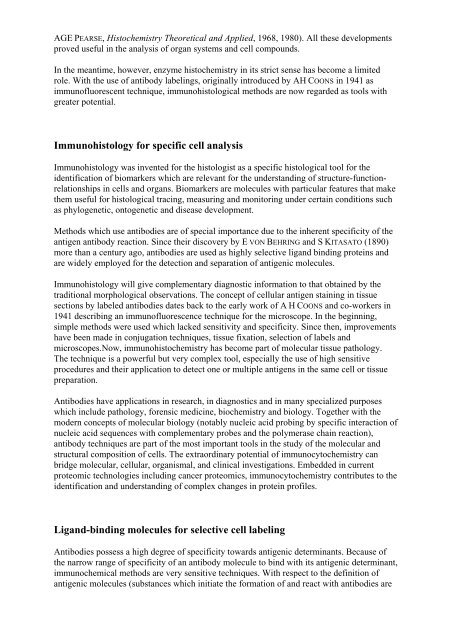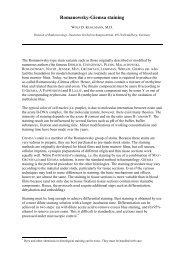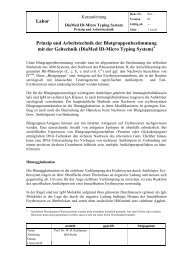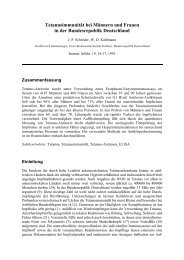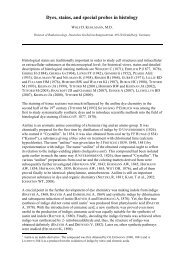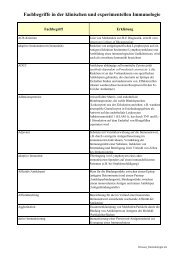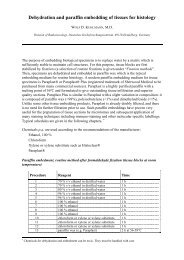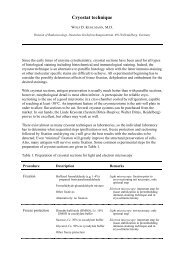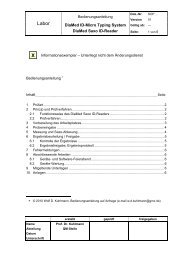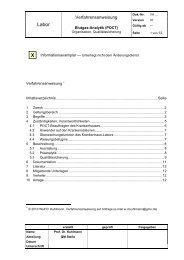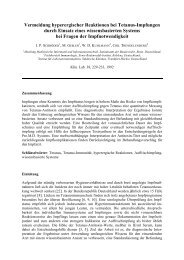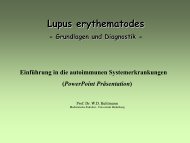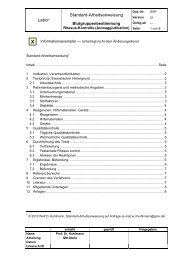AGE PEARSE, Histochemistry Theoretical and Applied, 1968, 1980). All these developmentsproved useful in the analysis of organ systems and cell compounds.In the meantime, however, enzyme histochemistry in its strict sense has become a limitedrole. With the use of antibody labelings, originally introduced by AH COONS in 1941 asimmunofluorescent technique, immunohistological methods are now regarded as tools withgreater potential.Immunohistology for specific cell analysisImmunohistology was invented for the histologist as a specific histological tool for theidentification of biomarkers which are relevant for the understanding of structure-functionrelationshipsin cells and organs. Biomarkers are molecules with particular features that makethem useful for histological tracing, measuring and monitoring under certain conditions suchas phylogenetic, ontogenetic and disease development.Methods which use antibodies are of special importance due to the inherent specificity of theantigen antibody reaction. Since their discovery by E VON BEHRING and S KITASATO (1890)more than a century ago, antibodies are used as highly selective ligand binding proteins andare widely employed for the detection and separation of antigenic molecules.Immunohistology will give complementary diagnostic information to that obtained by thetraditional morphological observations. The concept of cellular antigen <strong>staining</strong> in tissuesections by labeled antibodies dates back to the early work of A H COONS and co-workers in1941 describing an immunofluorescence technique for the microscope. In the beginning,simple methods were used which lacked sensitivity and specificity. Since then, improvementshave been made in conjugation <strong>techniques</strong>, tissue fixation, selection of labels andmicroscopes.Now, immunohistochemistry has become part of molecular tissue pathology.The technique is a powerful but very complex tool, especially the use of high sensitiveprocedures and their application to detect one or multiple antigens in the same cell or tissuepreparation.Antibodies have applications in research, in diagnostics and in many specialized purposeswhich include pathology, forensic medicine, biochemistry and biology. Together with themodern concepts of molecular biology (notably nucleic acid probing by specific interaction ofnucleic acid sequences with complementary probes and the polymerase chain reaction),antibody <strong>techniques</strong> are part of the most important tools in the study of the molecular andstructural composition of cells. The extraordinary potential of immunocytochemistry canbridge molecular, cellular, organismal, and clinical investigations. Embedded in currentproteomic technologies including cancer proteomics, immunocytochemistry contributes to theidentification and understanding of complex changes in protein profiles.Ligand-binding molecules for selective cell labelingAntibodies possess a high degree of specificity towards antigenic determinants. Because ofthe narrow range of specificity of an antibody molecule to bind with its antigenic determinant,immunochemical methods are very sensitive <strong>techniques</strong>. With respect to the definition ofantigenic molecules (substances which initiate the formation of and react with antibodies are
called antigens), immunological methods are widely employed in qualitative and quantitativeapproaches since the very early years of the last century e.g. by EHRLICH, LANDSTEINER,WITEBSKY, HEIDELBERGER, MARRACK, KABAT, OUDIN, GRABAR and schools derived fromthese pioneers in immunochemistry.Several types of antibody preparations exist for immunocytochemistry. These includeantibodies of polyclonal or monoclonal origin; a pool of monoclonal antibodies is also useful.Polyclonal antibodies are readily obtained from animals (e.g. rabbit, goat, sheep, mouse orrat) upon immunization with appropriate antigen. Also, autoantibodies from patients withcertain diseases may be used. These immune sera, however, will contain a mixture ofnumerous antibody populations directed against the different epitopes of the immunizingantigen. Hence, hyperimmune sera will suffer from the drawback of limited reproducibility.In order to overcome this problem, monoclonal antibodies will be a good alternative; they canbe obtained by hybridoma <strong>techniques</strong>. Their great reproducibility and inherent antigenspecificity for defined antigenic epitopes make monoclonal antibodies useful tools inimmunological <strong>techniques</strong>.Furthermore, genetic engineering such as phage display enables the production ofrecombinant antibodies. Usually, the sophisticated protein folding and modificationmachinery of mammalian cells is needed to obtain biologically active antibodies. Some ofthese limitations can be overcome by using smaller antigen-binding fragments of antibodieslike Fab fragments which can be produced in E. coli. Then, alternative protein architectureswhich are easier to handle may become attractive. A novel class of engineered ligand-bindingproteins such as the anticalins provide suitable properties as laboratory and diagnostic tools.A number of phenomena which resemble antibody reaction are shared by lectins. These occurin a variety of plants, invertebrates and vertebrates and are used for the study of carbohydratemoieties. With their ubiquitous role in virtually all biological systems, glycans are vitallyimportant molecules. Glycans are a large group of compounds consisting of sugars withdiverse structures that are present inside and on the surface of cells. More than 50% of allproteins carry various glycan chains. They fulfill many different roles by interacting withproteins in a variety of biological events which underlie the development and function inmulticellular organisms. Because lectins possess a high affinity and a narrow range ofspecificity for defined sugar residues, they are a powerful tool in carbohydrate studies.Lectins are today the most specific molecular probes for the histological localisation ofglycoconjugate glycosylation. The principles described for immunohistology hold also truefor lectin histology. In a similar way to immunohistological <strong>techniques</strong>, lectins which areeither conjugated with markers such as fluorescein, enzymes etc. or not can be employed in“direct” and “indirect” <strong>staining</strong> procedures. In the latter <strong>techniques</strong>, a defined labeledantibody system is needed to localize the reaction site of the lectin itself.In situ <strong>staining</strong> of molecules in cells and tissue preparationsWith respect to immunocytochemistry, the purpose of most described procedures is theidentification and characterization of cellular structure and function in situ rather thanimmuno-<strong>staining</strong> of physicochemically isolated constituents. Because the principles ofimmunohistology hold also true for nucleic acid <strong>staining</strong> by DNA and RNA hybridization<strong>techniques</strong>, both <strong>techniques</strong> are candidates to be joined in the study of life processes whichdepend so much on multiple external and intrinsic conditions. Usually, only parts of thegenome become expressed as RNAs which concentrations, however, are not strongly


